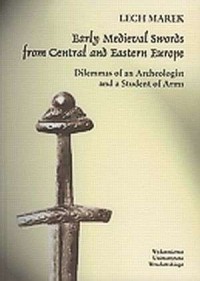Early Medieval Swords from Central and Eastern Europe. Dilemmas of an Archeologist and a Student of Arms
Lech Marek

| Dane szczegółowe: | |
| Wydawca: | Wydawnictwo Uniwersytetu Wrocławskiego |
| Rok wyd.: | 2005 |
| Oprawa: | miękka |
| Ilość stron: | 158 s. |
| Wymiar: | 168x238 mm |
| EAN: | 9788322926246 |
| ISBN: | 83-229-2624-3 |
| Data: | 2005-07-08 |
Opis książki:
Early medieval swords, among other contemporary artifacts, appear to be one of the most informative sources which may tell us about the ancient metallurgical craft, warfare, and cultural influences in Europe after the fall of the Western Roman Empire. The material gathered in this work is dated from the 6th to the 12th cent. - the time when the ornamentation of swords and specific sword-forms bears a more or less noticeable trace of Frankish cultural influence. The incessant evolution of arms and numerous processes associated with this phenomenon cannot easily be confined by chronologi-cal schemes. Being aware of the latter, I must emphasize the corwentional-ity of the chronology outlined in this paper. The territory investigated in this work, in a geographical sense, is enclosed within the boundaries of Central Europe as drawn by Professor K. Jażdżewski in his work from 1981. Cultur-ally it may be considered as the region of Central and Eastern Europe. The artifacts examined come from Poland, the Czech Republic, Slovakia, Hun-gary, the Ukraine, Belorus, Russia, Germany, Austria and the Netherlands. For the sake of complicity, when writing about local sword-hilt production and southern cultural influence, I shall refer to archeological finds from Croatia. Swords found in Scandinavia and on the British Isles will be occa-sionally mentioned, when needed for comparison. The knowledge of arti-facts from France is still poor, which is partly caused by the lack of a mo-dern treatise on early medieval swords from this country and by the rarity of finds from the second half of the 8th cent. and onwards, when a ban to eąuip the deceased in grave goods on the territory of the Carolingian Monarchy was established. It is worth mentioning that most of the early medieval swords from Central and Eastern Europe were found as grave goods (Kirpichniko Y 1966, p. 22; J. Wrzesiński, A. Wrzesiński 1995, p. 213)
Książka "Early Medieval Swords from Central and Eastern Europe. Dilemmas of an Archeologist and a Student of Arms" - Lech Marek - oprawa miękka - Wydawnictwo Uniwersytetu Wrocławskiego. Książka posiada 158 stron i została wydana w 2005 r.
Spis treści:
Chapter 1. The ąuestion of classification
Chapter 2. Embellishment of sword-hilts
A. Swords of distinctive types 1, 2 and of the MANNHEIM type
B. Type D
C. Type S
D. Problems associated with horn-hilts
E. Ornamentation of Z-type sword-hilts
Chapter 3. Technological aspects of the blade construction A. Blade structures
B. Blade forms
Chapter 4. Inscriptions and symbols on swords
A. Names of ambiguous meaning
B. Names of sword-smiths
C. Invocations
D. HARTOLFA and HILTIPREHT inscriptions
E. Magic and closing symbols
Chapter 5. The sword as a weapon and symbol
Conclusion
Plates
List of plates
Literature
Catalogue
Maps

